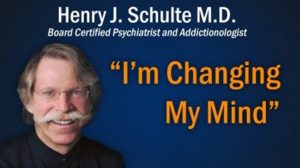Update on a New Treatment for Major Depression
By H.J. Schulte, M.D., D.F.A.P.A
Recall the worst you have ever felt with influenza — the headaches, the body aches,he joint muscle aches— everything hurts!Take away the nausea, vomiting or cough and that is what severe depression can feel like. It’s a whole body disease.
Severe Major Depressive Disorder injures and pains our bio, psycho, social, spiritual beingness. It stops many from functioning at work and at home. It cripples one’s ability to love and to work and to enjoy life. I would like to review the symptoms of Major Depression, the findings of the STAR D study*(Sequenced Treatment Alternative to Relieve Depression Study), how often Major Depression occurs, its cost and highlight a new treatment called repetitive Transcranial Magnetic Stimulation for treatment resistant Major Depressive Disorder.
Symptoms of Major Depression
The symptoms of Major Depression include the following:
• Depressed mood or apathy/loss of interest.
• Four or more required: sleep disturbance, executive dysfunction, worthlessness/guilt, weight/ appetite changes, psychomotor agitation or retardation, fatigue or suicidal ideation.
• It must significantly interfere with the functioning of the individual at work, at home or socially. Frequently, it affects all those areas.
It is a little odd that someone can have Major Depressive Disorder but not have a depressed mood. I think we have all seen this can occur. We sometimes explain it as person who is out of touch with their emotions or may not know how to access them such as in alexithymia or perhaps it’s a macho football player. Nonetheless, it can occur if one meets the criteria instead of having depressed mood. Anhedonia is an important hallmark for Major Depressive Disorder. A person may present with apathy/loss of interest (anhedonia).
In the future Major Depressive Disorder will likely consist of several different genetically defined illnesses. A patient may present with an extreme anxiety, insomnia, agitation, restlessness depressive symptom profile. Or a patient may be very lethargic, oversleep, complain of fatigue and be unmotivated to do anything they used to enjoy doing. Currently
we are labeling them with the same name but the clinical presentations can be drastically different.
In the STAR D study that was reported in American Journal of Psychiatry in 2005, 4,000 patients from 41 clinics were monitored and treated for one year. These were real life patients in medical and psychiatric clinics who also suffered from
substance abuse, chronic pain and family issues. The study was a landmark because it looked at the treatment of depression in the clinical treatment settings. The study was designed so every three months if one did not go into remission from the first treatment, they were then put into the next level with different treatments. The goal of the treatment was remission which implied that the person was back to their normal functioning. Response, on the other hand, is a 50% improvement on the Hamilton Depression Scale. The reason remission is so important is that if the patient does not get fully into remission, they are much more likely to have increased relapsed rates of depression that can cause significant mortality and morbidity. There is also increased risk for suicide and increased risk for significant negative effects on the family, occupation and health of the individual.*
STAR D
In the STAR D study level one involved the three months treatment with Citalopram (Celexa). Those who did not respond went on to level two where they were randomly assigned to either Sertraline, (Zoloft), Bupropion- SR/ (Wellbutrin) or Venlafaxine-XR( Effexor). Bupropion was used both independently and as an add on to other medications. As in level one, those who became symptom free with level two could continue with treatment and in to the follow up. Participants could always switch to, or add on cognitive psychotherapy. Those who did not become symptom free would continue to level three. In level three, participants had the option of either switching to another medication or adding on to their existing medication. They were randomly assigned to Mirtazapine (Remeron) or Nortriptyline (Pamelor) a tricyclic antidepressant.
In level three, either Lithium or Thyroid was added to bolster the antidepressant action. In level four those who did not become symptom free where taken off of all their other antidepressants and were given a trial of a monoamine oxidase inhibitor antidepressant namely, Tranylcypromine (Parnate) or Venlafaxine XR with Mirtazapine.
Measurement-based care was used to asset the patient’s progress at each level.
In summary, about 70% of patients reached remission, however this left about 30% of patients who did not. The odds of beating the depression diminished with each additional treatment strategy that was needed. The drop-out rate also increased significantly with each progressive treatment level. Forty percent of the patients had side effects, some of them significant.
If someone experienced one episode of Major Depression in their life, there is about a 50% chance of it reoccurring. If someone experienced two episodes of Major Depression, the risk of it reoccurring goes up to 70%. After three episodes of Major Depression, the likelihood of it reoccurring is 90%. By the second recurrent episode it recommended patients stay on medications ongoing to help prevent further relapses. MDD can be seen as a Chronic Medical Illness similar to Hypertension, Diabetes, Heart Disease or Autoimmune Diseases.
The risk of having major depression is about 17% for adults in their lifetime. The yearly risk for Major Depression is about 8%. The yearly risk for Anxiety Disorder is about 10%; Substance Abuse Disorder incidence is about 10%. The lifetime risk for both of those disorders is about 25%.
How Common is Depression?
“Depression is a common mental disorder. Globally, more than 300 million people of all ages suffer from it. Depression is the leading cause of disability worldwide, and is a large contributor to the over global burden of disease,” “Annual costs related to MDD rose to $210.5 billion in 2010, according to the study published in the Journal of Clinical Psychiatry.” February 25, 2015.
Hope for Healing
Amazing advances have been made in brain chemistry. It is very exciting and hopeful to learn about neuroplasticity and how we can help our brain grow and heal. There is an explosion in neuroscience that brought with it many wonderful psychiatric medications which have been very helpful to help treat the symptoms of Major Depressive Disorder.
Pills don’t teach skills. I have a strong belief that people with Major Depressive Disorder, as well as many other psychiatric disorder benefits from psychotherapy. There have been significant advances made in the psychotherapy world of new treatments, many which are very helpful. Allbeit the stigma and barriers to treatment for psychotherapy and psychiatric illnesses continue, there is also a great deal of progress in accepting psychotherapy and medication treatment for
psychiatric illnesses.
For treatment resistant depression the psychiatric profession employs Electroconvulsive Therapy (ECT). This is still one of the most powerful treatments for treatment resistant depression. However, it comes with significant drawbacks which involve having anesthesia for each treatment of which there about twenty over the course of a month. It is performed in such way that confusion and memory problems are less than they used to be.
TMS
Transcranial Magnetic Stimulation (rTMS) was FDA approved in 2008 for the treatment of severe treatment resistant Major Depressive Disorder. In 1985 the first TMS study was performed by Anthony Barker in Sheffield England. Some of his students reported the electromagnetic stimulation he was using to stimulate the brain caused them to feel less depressed. Over the years, there was a great deal of interest in how to apply electromagnetic stimulation for the treatment of depression. There were problems of where to do the treatment, how strong to make it and how to get back to the same site consistently.
In the early 2000’s PET scans showed that in Major Depression Disorder, the left prefrontal cortex is low in metabolism. Other lower brain regions had increased metabolism. By applying electromagnetic stimulation to the prefrontal cortex of the brain over a period of time there was a decrease or severe symptoms in this treatment resistant group. In order
to get FDA approval, rTMS was successful in getting about 50% of patients into response and about 30% of patients having a remission. These are similar results that prompted FDA approval of the early serotonin reuptake inhibitor antidepressants such as Prozac. You may recall remission is symptom free and response is greater than 50% decreased in symptoms on the Hamilton Depression rating scale. These findings were reported in a study of the first hundred patients treated in the first year after receiving FDA approval. Now, after nine years of experience our response rates are rates are around 70% and our remission rates are about 40%. The reason for this is we now leave patients on medications during treatment and the treatment is extended from four to six weeks. The treatment consists of daily 37 minutes treatment of rapid pulses of electromagnetic waves given to the left dorsolateral prefrontal cortex.
Electrical pulsing stimulation is directed towards a magnet and the magnet then sends off an electromagnetic wave that goes thru the scalp and into the brain about 3cm. This creates an electrical pulse inside of the brain causing neurons to depolarize and regenerate. This stimulation is to the left upper part of the prefrontal cortex, however, it also changes other areas of the brain, because the brain operates in tracts.

TMS stimulation is to the left upper part of the prefrontal cortex,
however, it also changes other areas of the brain, because the brain
operates in tracts.
NeuroStar was the first company to invent the machine that successfully accomplished getting FDA approval. In the initial study the dropout rate was about 4% due to headaches. Most practitioners have very few dropouts from headaches because we tend to go lower and slower than they did in the study. FDA approval was obtained after the first 10,000 treatments in several studies. Between 10,000 and 100,000 treatments there were three episodes of grand mal seizures. This may have been due to drug abuse, changing medications and/or treatment error.
The treatment error has been corrected by changing the algorithm on the machine. Now NeuroStar has had about 1.5 million treatments and no further episodes of seizures. There are about three to four other machines on the market providing similar treatment. Their seizure rate may be a little higher than the rate with NeuroStar.
Currently there are about 400 providers across the country providing rTMS treatment in their office. It is also available in the top 10 medical schools outpatient departments. Cost has been a factor in terms of the slow growth of rTMS usage. Because of its success rate with a very ill patient population and its lower cost than ECT with less side effects, it is now being covered by most insurance companies.
As you would imagine, insurance companies have strict criteria for treatment involving failing three to four antidepressants as well as failing add on treatments for depression. Psychotherapy treatment needs to be carefully documented with clinical based instruments such as the Beck Depressions Inventory scale or the Patient Health Questionnaire.
If you have clients or patients who are profoundly, severally depressed and are resistant to treatment you may consider rTMS as a treatment option for them. Significant research applications of TMS for other illnesses are being done by Alvaro Pascual-Leone MD, PHD. For more information visit the TMS Clinical Society on line at https://clinicaltmssociety.org
*Trivedi MH, ET AL J Psychiatry 2006: 163:
28-40
*Zajecka JM. J Cline Psychiatry. 2003: 64 (Suppl
15): 7-12
*World Health Organization: DEPRESSION;
fact sheet, updated February 2017
Interested in learning more?
Call Karlie, our TMS coordinator,
if you have any further questions
about rTMS treatment or insurance
coverage at (480) 941-9004.
The Schulte Institute
7101 E. Indian School Road, Scottsdale, AZ 85251


